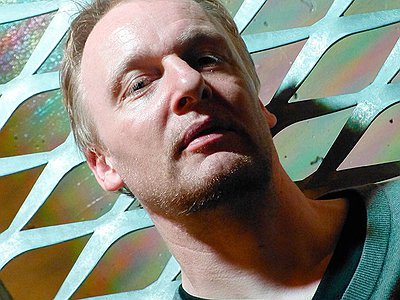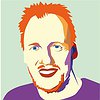Name: Bernhard Wöstheinrich
Nationality: German
Occupation: Composer, Improviser, Producer
Bands/Projects: centrozoon, The Redundant Rocker
Labels: Burning Shed, DIN, Iapetus, Tonefloat, Unsung
Musical Recommendations: Michael Peters, far away from the musical mainstream, he is always looking for new sound worlds: polyrhythmic minimal music, ambient sound clouds, avantgarde rock, abstract and atonal experiments, algorithmic compositions, field recordings, guitar and livelooping.
Korhan Erel, multifaceted and narrative electronic music: far away from clichés of electronic music, somehow like abstract painting, with a technical virtuosity and subtlety. He newly defines the use of electronics: he doesn't try to sound like a certain piece of gear or like another musical instrument but makes his computer his very own voice/instrument. He builds his music/tunes from fragments of field recordings, granulated in different sizes so that he can compose from these parts quotes or real sounds. I listened to him playing with David Rothenberg in Istanbul, he had recordings of nightingale voices, he can play nightingale songs or he can use fragments of this recording and modulate them: repeat them, tune them, so they become a special sound, and the transitions are so smooth that his music becomes very complex and colourful, like an abstract narration.
When did you start writing/producing music – and what or who were your early passions and influences?
About 1987, at college, I learned that drawing and painting alone wasn't enough for me in order to express myself. I was interested in performance and music, so I started looking for instruments to play. I went up to my brother Albert who was playing the bass in a wave electro-punk band named Vita Transit with two Italian lady singers. I wanted to borrow whichever musical instrument – it turned out that he needed the bass himself, the drumset was broken, and so I went home with some electronic gear: a mixing desk, a Korg MS 20, a Casio SK1 and an Electro Harmonix Mini-Synthesizer.
Afterwards I started to experiment with my own sounds and tunes inspired by bands like Die Einstürzenden Neubauten, Cabaret Voltaire, Ministry, Tuxedomoon and their likes. I developed an early approach of composing and recording. I also met a lot of people very soon after I had started to make music, because Bielefeld, the city where I studied, used to have an extensive network of musicians. While I was exploring new possibilities of making music I rediscovered early electronic stuff like Klaus Schulze and Tangerine Dream.
For most artists, originality is first preceded by a phase of learning and, often, emulating others. What was this like for you? How would you describe your own development as an artist and the transition towards your own voice?
In the very beginning I tried to sound like those industrial bands of that time; with my Casio SK 1 I sampled sounds – for instance a snare drum - and created a pounding sequence with that. And I tried to compose music pieces layering tracks in an improvised multi-track recording system.
I met Thorsten Niestrath at school and we founded a band with a drummer, a percussionist and a bass player. This band was later called Subsonic Experience. Making music with others really opened up a completely new world. I got hooked. I played the organ in that band and we jammed together. Suddenly a piece of music was there instantly and the complexity of the music was so much bigger than anything I could do on my own.
This first band didn’t survive for a long time. So Thorsten and I continued by ourselves, consciously relating to bands and musicians like Popol Vuh, Peter Michael Hamel, Steve Roach, Kluster, Neu!, Brian Eno, Eberhard Schoener and of course Klaus Schulze and Edgar Froese, by trying to make electronic music in a krautrock spirit.
What were your main compositional- and production-challenges in the beginning and how have they changed over time?
In the beginning the challenge was to multiply my own voice (instruments) using a professional multi-track device. Focusing on live performances the challenge was more and more to be able to master my several instruments on stage: a couple of solo keyboard parts and a rhythm section that also had to be modulated on stage in real time.
There were a lot of answers and solutions for that challenge. In the middle of the nineties, the groove boxes from deejaying became popular and you could program rhythms and spontaneously generate accompanying patterns.
At the end of the nineties my music became more professional in terms of recording and producing. So finally I was focusing more on preparing each live set-up in a way that I could be used later in a professional studio production.
For centrozoon’s Blast or Never Trust The Way You Are we worked with the singer Tim Bowness and different from our usual open approach we came back to a song pattern that could be reproduced on stages and be arranged for a CD release.
Tell us about your studio, please. What were criteria when setting it up and how does this environment influence the creative process? How important, relatively speaking, are factors like mood, ergonomics, haptics and technology for you?
My studio was an attic or a shed, a spare room with some forgotten furniture that could have been used for parties as well. We tried to have a good time there, jamming together krautrock style. This way Studio Flokati was founded, and named after this furry white greek carpet that was lying around there.
Those rooms in the long run became more and more clinical: basically all you need are a good speaker system, audio interface and a computer.
After moving to Berlin, I have my office, my set-up there being a more or less average and sufficiently equipped home studio, I guess. For serious productions we use a professional studio, but I also have the possibility to retire to a basement with piles of vintage keyboards and jam away with friends. We also started doing live-on-air radio shows with companioned musicians on RSD Radio & MODUL 303 from there.
What are currently some of the most important tools and instruments you're using?
First of all it is the Ableton Live software. In the mid-1990s I was talking to a friend describing what my favourite music software would be like and some years later this Ableton software fulfilled my desires.
I recently went to a music store here in Berlin and looked around for new inspirations and didn’t find anything that attracted me more than the Ableton Push interface. It is very flexible and ergonomic, easy to use, I have total control and can concentrate on the music without having to think about the interface as much. My favorite Plug-Ins for Ableton Live I are Smart Electronix and Arto Vaarala among others.
Many contemporary production tools already take over significant parts of what would formerly have constituted compositional work. In which way do certain production tools suggest certain approaches, in which way do they limit and/or expand your own creativity? Are there any promising solutions or set-ups capable of triggering new ideas inside of you as a composer?
I guess the actual question here is what is “compositional work” and in which degree of complexity one would like to work. Due to the fact the most of the tools have a certain background (like DJing, Arranging and Mastering, Solo-Musicians e. g.) of course they all suggest a particular way of working with them. Most production tools that suggest ready made solutions aren’t really interesting to me.
As my compositions usually happen onstage I am interested in easier ways of handling tools and I also am interested in tools that allow a more performative approach than just sitting in front of the computer and moving the mouse. So that the audience can follow my music more.



